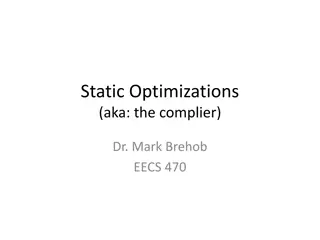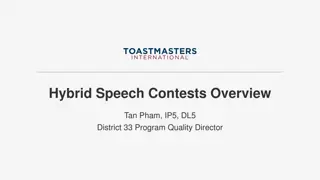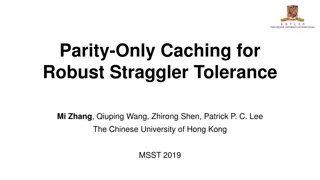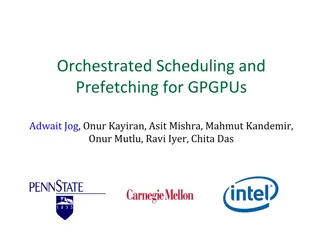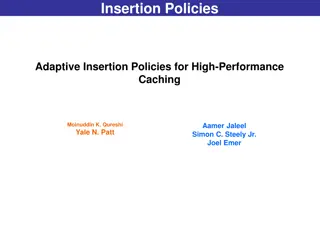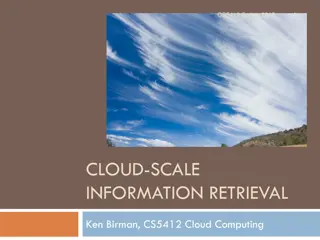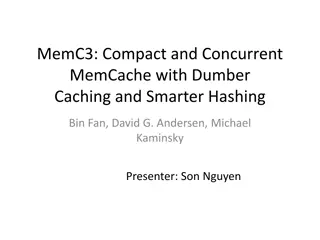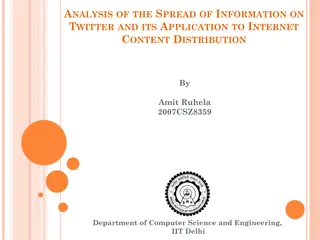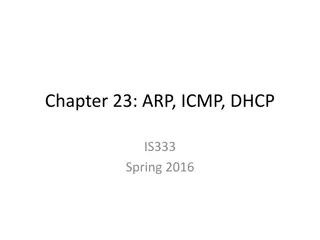Locality-Aware Caching Policies for Hybrid Memories
Different memory technologies present unique strengths, and a hybrid memory system combining DRAM and PCM aims to leverage the best of both worlds. This research explores the challenge of data placement between these diverse memory devices, highlighting the use of row buffer locality as a key criterion for efficient data placement. By caching to DRAM rows with low RBL and high reuse, performance and energy efficiency improvements are achieved over existing caching policies, catering to the escalating demand for memory capacity in modern data-intensive applications. Emerging high-density memory solutions, such as Phase Change Memory (PCM), offer promising alternatives to DRAM but come with their own set of challenges. Hybrid memory architectures, benefiting from both DRAM's low latency and PCM's high capacity, require efficient design principles to capitalize on the strengths of each memory technology while mitigating drawbacks.
Download Presentation

Please find below an Image/Link to download the presentation.
The content on the website is provided AS IS for your information and personal use only. It may not be sold, licensed, or shared on other websites without obtaining consent from the author.If you encounter any issues during the download, it is possible that the publisher has removed the file from their server.
You are allowed to download the files provided on this website for personal or commercial use, subject to the condition that they are used lawfully. All files are the property of their respective owners.
The content on the website is provided AS IS for your information and personal use only. It may not be sold, licensed, or shared on other websites without obtaining consent from the author.
E N D
Presentation Transcript
Row Buffer Locality Aware Caching Policies for Hybrid Memories HanBin Yoon Justin Meza Rachata Ausavarungnirun Rachael Harding Onur Mutlu
Executive Summary Different memory technologies have different strengths A hybrid memory system (DRAM-PCM) aims for best of both Problem: How to place data between these heterogeneous memory devices? Observation: PCM array access latency is higher than DRAM s But peripheral circuit (row buffer) access latencies are similar Key Idea: Use row buffer locality (RBL) as a key criterion for data placement Solution: Cache to DRAM rows with low RBL and high reuse Improves both performance and energy efficiency over state-of-the-art caching policies 2
Demand for Memory Capacity 1. Increasing cores and thread contexts Intel Sandy Bridge: 8 cores (16 threads) AMD Abu Dhabi: 16 cores IBM POWER7: 8 cores (32 threads) Sun T4: 8 cores (64 threads) 3
Demand for Memory Capacity 1. Increasing cores and thread contexts Intel Sandy Bridge: 8 cores (16 threads) AMD Abu Dhabi: 16 cores IBM POWER7: 8 cores (32 threads) Sun T4: 8 cores (64 threads) 2. Modern data-intensive applications operate on increasingly larger datasets Graph, database, scientific workloads 4
Emerging High Density Memory DRAM density scaling becoming costly Promising: Phase change memory (PCM) + Projected 3 12 denser than DRAM [Mohan HPTS 09] + Non-volatile data storage However, cannot simply replace DRAM Higher access latency (4 12 DRAM) [Lee+ ISCA 09] Higher dynamic energy (2 40 DRAM) [Lee+ ISCA 09] Limited write endurance ( 108 writes) [Lee+ ISCA 09] Employ both DRAM and PCM 5
Hybrid Memory Benefits from both DRAM and PCM DRAM: Low latency, dyn. energy, high endurance PCM: High capacity, low static energy (no refresh) CPU MC MC DRAM PCM 6
Hybrid Memory Design direction: DRAM as a cache to PCM [Qureshi+ ISCA 09] Need to avoid excessive data movement Need to efficiently utilize the DRAM cache CPU MC MC DRAM PCM 7
Hybrid Memory Key question: How to place data between the heterogeneous memory devices? CPU MC MC DRAM PCM 8
Outline Background: Hybrid Memory Systems Motivation: Row Buffers and Implications on Data Placement Mechanisms: Row Buffer Locality-Aware Caching Policies Evaluation and Results Conclusion 9
Hybrid Memory: A Closer Look CPU Memory channel Row buffer MC MC Bank Bank Bank Bank DRAM (small capacity cache) PCM (large capacity store) 10
Row Buffers and Latency Bank CELL ARRAY ROW ADDRESS ROW DATA Row buffer miss! Row buffer hit! Row buffer Row (buffer) hit: Access data from row buffer fast Row (buffer) miss: Access data from cell array slow LOAD X LOAD X+1 LOAD X+1 LOAD X 11
Key Observation Row buffers exist in both DRAM and PCM Row hit latency similar in DRAM & PCM [Lee+ ISCA 09] Row miss latency small in DRAM, large in PCM Place data in DRAM which is likely tomiss in the row buffer (low row buffer locality) miss penalty is smaller in DRAM AND is reusedmany times cache only the data worth the movement cost and DRAM space 12
RBL-Awareness: An Example Let s say a processor accesses four rows Row A Row B Row C Row D 13
RBL-Awareness: An Example Let s say a processor accesses four rows with different row buffer localities (RBL) Row A Row B Row C Row D Low RBL (Frequently miss in row buffer) High RBL (Frequently hit in row buffer) Case 1: RBL-Unaware Policy (state-of-the-art) Case 2: RBL-Aware Policy (RBLA) 14
Case 1: RBL-Unaware Policy A row buffer locality-unaware policy could place these rows in the following manner Row C Row D Row A Row B DRAM (High RBL) PCM (Low RBL) 15
Case 1: RBL-Unaware Policy Access pattern to main memory: A (oldest), B, C, C, C, A, B, D, D, D, A, B (youngest) time DRAM (High RBL) C C C D D D PCM(Low RBL) A B A B A B RBL-Unaware: Stall time is 6 PCM device accesses 16
Case 2: RBL-Aware Policy (RBLA) A row buffer locality-aware policy would place these rows in the opposite manner Row A Row B Row C Row D DRAM (Low RBL) PCM (High RBL) Access data at lower row buffer miss latency of DRAM Access data at low row buffer hit latency of PCM 17
Case 2: RBL-Aware Policy (RBLA) Access pattern to main memory: A (oldest), B, C, C, C, A, B, D, D, D, A, B (youngest) time DRAM (High RBL) C C C D D D PCM(Low RBL) A B A B A B RBL-Unaware: Stall time is 6 PCM device accesses DRAM (Low RBL) PCM(High RBL) A B A A B B C C C D D D Saved cycles RBL-Aware: Stall time is 6 DRAM device accesses 18
Outline Background: Hybrid Memory Systems Motivation: Row Buffers and Implications on Data Placement Mechanisms: Row Buffer Locality-Aware Caching Policies Evaluation and Results Conclusion 19
Our Mechanism: RBLA 1. For recently used rows in PCM: Count row buffer misses as indicator of row buffer locality (RBL) 2. Cache to DRAM rows with misses threshold Row buffer miss counts are periodically reset (only cache rows with high reuse) 20
Our Mechanism: RBLA-Dyn 1. For recently used rows in PCM: Count row buffer misses as indicator of row buffer locality (RBL) 2. Cache to DRAM rows with misses threshold Row buffer miss counts are periodically reset (only cache rows with high reuse) 3. Dynamically adjust threshold to adapt to workload/system characteristics Interval-based cost-benefit analysis 21
Implementation: Statistics Store Goal: To keep count of row buffer misses to recently used rows in PCM Hardware structure in memory controller Operation is similar to a cache Input: row address Output: row buffer miss count 128-set 16-way statistics store (9.25KB) achieves system performance within 0.3% of an unlimited- sized statistics store 22
Outline Background: Hybrid Memory Systems Motivation: Row Buffers and Implications on Data Placement Mechanisms: Row Buffer Locality-Aware Caching Policies Evaluation and Results Conclusion 23
Evaluation Methodology Cycle-level x86 CPU-memory simulator CPU: 16 out-of-order cores, 32KB private L1 per core, 512KB shared L2 per core Memory: 1GB DRAM (8 banks), 16GB PCM (8 banks), 4KB migration granularity 36 multi-programmed server, cloud workloads Server: TPC-C (OLTP), TPC-H (Decision Support) Cloud: Apache (Webserv.), H.264 (Video), TPC-C/H Metrics: Weighted speedup (perf.), perf./Watt (energy eff.), Maximum slowdown (fairness) 24
Comparison Points Conventional LRU Caching FREQ: Access-frequency-based caching Places hot data in cache[Jiang+ HPCA 10] Cache to DRAM rows with accesses threshold Row buffer locality-unaware FREQ-Dyn: Adaptive Freq.-based caching FREQ + our dynamic threshold adjustment Row buffer locality-unaware RBLA: Row buffer locality-aware caching RBLA-Dyn: Adaptive RBL-aware caching 25
System Performance FREQ FREQ-Dyn RBLA RBLA-Dyn 1.4 Normalized Weighted Speedup 1.2 10% 14% 17% 1 0.8 Benefit 1: Increased row buffer locality (RBL) in PCM by moving low RBL data to DRAM in PCM by moving low RBL data to DRAM Benefit 1: Increased row buffer locality (RBL) 0.6 Benefit 2: Reduced memory bandwidth consumption due to stricter caching criteria consumption due to stricter caching criteria Benefit 2: Reduced memory bandwidth 0.4 0.2 Benefit 3: Balanced memory request load between DRAM and PCM 0 Server Cloud Workload Avg 26
Average Memory Latency FREQ FREQ-Dyn RBLA RBLA-Dyn 1.2 Normalized Avg Memory Latency 14% 1 12% 9% 0.8 0.6 0.4 0.2 0 Server Cloud Workload Avg 27
Memory Energy Efficiency FREQ FREQ-Dyn RBLA RBLA-Dyn 1.2 13% 10% 7% Normalized Perf. per Watt 1 0.8 Increased performance & reduced data movement between DRAM and PCM 0.6 0.4 0.2 0 Server Cloud Workload Avg 28
Thread Fairness FREQ FREQ-Dyn RBLA RBLA-Dyn 1.2 Normalized Maximum Slowdown 7.6% 1 6.2% 4.8% 0.8 0.6 0.4 0.2 0 Server Cloud Workload Avg 29
Compared to All-PCM/DRAM 16GB PCM RBLA-Dyn 16GB DRAM 2 2 1.2 1.8 1.8 1.6 Normalized Weighted Speedup Normalized Max. Slowdown 1 1.6 1.4 29% 1.4 1.2 0.8 1 1.2 31% 0.8 1 0.6 0.6 0.8 0.4 0.4 0.6 Our mechanism achieves 31% better performance 0.2 0.4 than all PCM, within 29% of all DRAM performance 0 0.2 Weighted Speedup 0 Max. Slowdown Normalized Metric Perf. per Watt 0.2 0 30
Other Results in Paper RBLA-Dyn increases the portion of PCM row buffer hit by 6.6 times RBLA-Dyn has the effect of balancing memory request load between DRAM and PCM PCM channel utilization increases by 60%. 31
Summary Different memory technologies have different strengths A hybrid memory system (DRAM-PCM) aims for best of both Problem: How to place data between these heterogeneous memory devices? Observation: PCM array access latency is higher than DRAM s But peripheral circuit (row buffer) access latencies are similar Key Idea: Use row buffer locality (RBL) as a key criterion for data placement Solution: Cache to DRAM rows with low RBL and high reuse Improves both performance and energy efficiency over state-of-the-art caching policies 32
Row Buffer Locality Aware Caching Policies for Hybrid Memories HanBin Yoon Justin Meza Rachata Ausavarungnirun Rachael Harding Onur Mutlu




